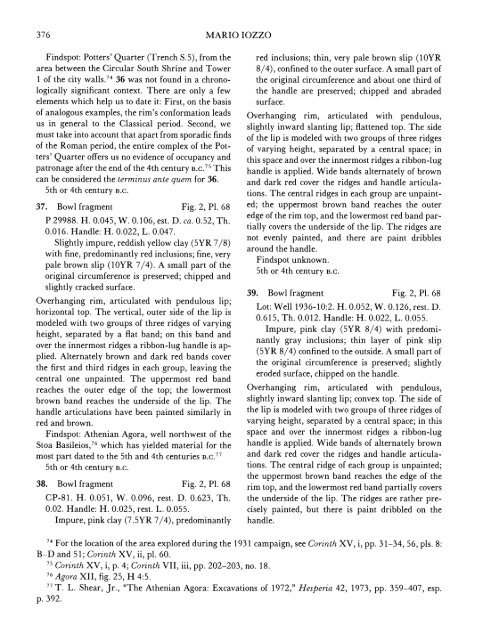f - The American School of Classical Studies at Athens
f - The American School of Classical Studies at Athens
f - The American School of Classical Studies at Athens
You also want an ePaper? Increase the reach of your titles
YUMPU automatically turns print PDFs into web optimized ePapers that Google loves.
376 MARIO IOZZO<br />
Findspot: Potters' Quarter (Trench S.5), from the<br />
area between the Circular South Shrine and Tower<br />
1 <strong>of</strong> the city walls.74 36 was not found in a chronologically<br />
significant context. <strong>The</strong>re are only a few<br />
elements which help us to d<strong>at</strong>e it: First, on the basis<br />
<strong>of</strong> analogous examples, the rim's conform<strong>at</strong>ion leads<br />
us in general to the <strong>Classical</strong> period. Second, we<br />
must take into account th<strong>at</strong> apart from sporadic finds<br />
<strong>of</strong> the Roman period, the entire complex <strong>of</strong> the Potters'<br />
Quarter <strong>of</strong>fers us no evidence <strong>of</strong> occupancy and<br />
p<strong>at</strong>ronage after the end <strong>of</strong> the 4th century B.C.75 This<br />
can be considered the terminus ante quem for 36.<br />
5th or 4th century B.C.<br />
37. Bowl fragment Fig. 2, P1. 68<br />
P 29988. H. 0.045, W. 0.106, est. D. ca. 0.52, Th.<br />
0.016. Handle: H. 0.022, L. 0.047.<br />
Slightly impure, reddish yellow clay (5YR 7/8)<br />
with fine, predominantly red inclusions; fine, very<br />
pale brown slip (1OYR 7/4). A small part <strong>of</strong> the<br />
original circumference is preserved; chipped and<br />
slightly cracked surface.<br />
Overhanging rim, articul<strong>at</strong>ed with pendulous lip;<br />
horizontal top. <strong>The</strong> vertical, outer side <strong>of</strong> the lip is<br />
modeled with two groups <strong>of</strong> three ridges <strong>of</strong> varying<br />
height, separ<strong>at</strong>ed by a fl<strong>at</strong> band; on this band and<br />
over the innermost ridges a ribbon-lug handle is ap-<br />
plied. Altern<strong>at</strong>ely brown and dark red bands cover<br />
the first and third ridges in each group, leaving the<br />
central one unpainted. <strong>The</strong> uppermost red band<br />
reaches the outer edge <strong>of</strong> the top; the lowermost<br />
brown band reaches the underside <strong>of</strong> the lip. <strong>The</strong><br />
handle articul<strong>at</strong>ions have been painted similarly in<br />
red and brown.<br />
Findspot: Athenian Agora, well northwest <strong>of</strong> the<br />
Stoa Basileios,76 which has yielded m<strong>at</strong>erial for the<br />
most part d<strong>at</strong>ed to the 5th and 4th centuries B.C.77<br />
5th or 4th century B.C.<br />
38. Bowl fragment Fig. 2, P1. 68<br />
CP-81. H. 0.051, W. 0.096, rest. D. 0.623, Th.<br />
0.02. Handle: H. 0.025, rest. L. 0.055.<br />
Impure, pink clay (7.5YR 7/4), predominantly<br />
red inclusions; thin, very pale brown slip (1OYR<br />
8/4), confined to the outer surface. A small part <strong>of</strong><br />
the original circumference and about one third <strong>of</strong><br />
the handle are preserved; chipped and abraded<br />
surface.<br />
Overhanging rim, articul<strong>at</strong>ed with pendulous,<br />
slightly inward slanting lip; fl<strong>at</strong>tened top. <strong>The</strong> side<br />
<strong>of</strong> the lip is modeled with two groups <strong>of</strong> three ridges<br />
<strong>of</strong> varying height, separ<strong>at</strong>ed by a central space; in<br />
this space and over the innermost ridges a ribbon-lug<br />
handle is applied. Wide bands altern<strong>at</strong>ely <strong>of</strong> brown<br />
and dark red cover the ridges and handle articula-<br />
tions. <strong>The</strong> central ridges in each group are unpaint-<br />
ed; the uppermost brown band reaches the outer<br />
edge <strong>of</strong> the rim top, and the lowermost red band par-<br />
tially covers the underside <strong>of</strong> the lip. <strong>The</strong> ridges are<br />
not evenly painted, and there are paint dribbles<br />
around the handle.<br />
Findspot unknown.<br />
5th or 4th century B.C.<br />
39. Bowl fragment Fig. 2, P1. 68<br />
Lot: Well 1936-10:2. H. 0.052, W. 0.126, rest. D.<br />
0.615, Th. 0.012. Handle: H. 0.022, L. 0.055.<br />
Impure, pink clay (5YR 8/4) with predomi-<br />
nantly gray inclusions; thin layer <strong>of</strong> pink slip<br />
(5YR 8/4) confined to the outside. A small part <strong>of</strong><br />
the original circumference is preserved; slightly<br />
eroded surface, chipped on the handle.<br />
Overhanging rim, articul<strong>at</strong>ed with pendulous,<br />
slightly inward slanting lip; convex top. <strong>The</strong> side <strong>of</strong><br />
the lip is modeled with two groups <strong>of</strong> three ridges <strong>of</strong><br />
varying height, separ<strong>at</strong>ed by a central space; in this<br />
space and over the innermost ridges a ribbon-lug<br />
handle is applied. Wide bands <strong>of</strong> altern<strong>at</strong>ely brown<br />
and dark red cover the ridges and handle articula-<br />
tions. <strong>The</strong> central ridge <strong>of</strong> each group is unpainted;<br />
the uppermost brown band reaches the edge <strong>of</strong> the<br />
rim top, and the lowermost red band partially covers<br />
the underside <strong>of</strong> the lip. <strong>The</strong> ridges are r<strong>at</strong>her pre-<br />
cisely painted, but there is paint dribbled on the<br />
handle.<br />
74 For the loc<strong>at</strong>ion <strong>of</strong> the area explored during the 1931 campaign, see Corinth XV, i, pp. 31-34, 56, pls. 8:<br />
B-D and 51; Corinth XV, ii, pl. 60.<br />
7 Corinth XV, i, p. 4; Corinth VII, iii, pp. 202-203, no. 18.<br />
76 Agora XII, fig. 25, H 4:5.<br />
7 T. L. Shear, Jr., "<strong>The</strong> Athenian Agora: Excav<strong>at</strong>ions <strong>of</strong> 1972," Hesperia 42, 1973, pp. 359-407, esp.<br />
p. 392.

















